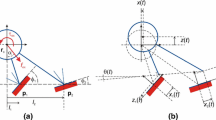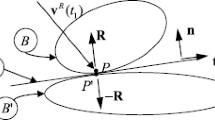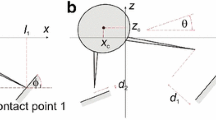Abstract
This paper introduces an analysis of tangential velocity of the contact point during a single-point impact with friction in three-dimensional rigid multibody systems. Considering the normal component of impulse at the contact point as the independent variable, a system of nonlinear differential equations describing the progress of the tangential velocity is derived. Quartic algebraic equations for the invariant and the flow change directions are obtained. The system of differential equations could have a discontinuity problem if the tangential velocity instantaneously vanishes. Effectively, this problem is mathematically solved and the new sliding direction is specified. During impact, the sliding direction could continuously change or the sliding could stop and the non-sliding continues or the sliding could restart along a new direction. The stick-slip effect could also have its influence. Two friction models are used, and an appropriate numerical procedure is suggested that can handle all the possible sliding scenarios. To verify the proposed method, the numerical solution is compared to the analytical solution for a special case of a homogeneous ellipsoid that collides with a horizontal fixed rough surface. A case study of a four-degrees-of-freedom spatial robot that collides with its environment is considered. The bifurcation associated with the variation of the kinetic coefficient of friction is investigated, and a set of threshold values of it are determined. Some phase portraits are drawn, and the invariant directions and flow change directions are drawn for all portraits. Each portrait represents all the flow trajectories of the tangential velocity for different initial conditions with a specific kinetic coefficient of friction. This qualitative analysis not only helps in understanding the behavior of multibody systems in such situations but also it gives insight to the physical phenomenon of impact itself.












Similar content being viewed by others
References
Routh, E.J.: Dynamics of a System of Rigid Bodies, 6th edn. Macmillan and Co., London (1897)
Whittaker, E.T.: A. Treatise on the Analytical Dynamics of Particles and Rigid Bodies. Cambridge University Press, Cambridge (1904)
Kane, T.R., Levinson, D.A.: Dynamic: Theory and Applications. McGraw-Hill, New York (1985)
Keller, J.B.: Impact with friction. J. Appl. Mech-T. ASME 53, 1–4 (1986)
Stronge, W.J.: Rigid body collisions with friction. Proc. R. Soc. Lond. A431, 169–181 (1990)
Elkaranshawy, H.A., Mohamed, K.T., Ashour, A.S., Alkomy, H.M.: Solving Painlevé paradox: (P–R) sliding robot case. Nonlinear Dyn. 88(3), 1691–1705 (2017)
Stronge, W.J.: Swerve during three-dimensional impact of rough rigid bodies. J. Appl. Mech-T. ASME 61, 605–611 (1994)
Bhatt, V., Koechling, J.: Partitioning the parameter space according to different behaviors during three-dimensional impact. J. Appl. Mech-T. ASME 62, 740–746 (1995)
Bhatt, V., Koechling, J.: Three-dimensional frictional rigid-body impact. J. Appl. Mech-T. ASME 62, 893–898 (1995)
Battle, J.A.: The sliding velocity flow of rough collisions in multi-body systems. J. Appl. Mech-T. ASME 63, 804–809 (1996)
Batlle, J.A., Cardona, S.: The jamb (self-locking) process in three-dimensional collisions. J. Appl. Mech-T. ASME 65, 417–423 (1998)
Mirtich, B., Canny, J.: Impulse-based simulation of rigid bodies. In: Proceedings of the Symposium on Interactive 3D Graphics, pp. 181–189 (1995)
Zhang, Y., Sharf, I.: Rigid body impact modeling using integral formulation. J. Comput. Nonlin. Dyn. 2, 98–102 (2007)
Elkaranshawy, H.A.: Rough collisions in three-dimensional rigid multi-body system. Proc. Inst. Mech. Eng. Part K J. Multi Body Dyn. 221, 541–550 (2007)
Elkaranshawy, H.A.: Spatial robotic systems subjected to impact with friction. In: Proceedings of the IASTED International Conference on Robotics, Pittsburgh, pp. 269–277 (2011). doi:10.2316/P.2011.752-047
Elkaranshawy, H.A., Abdelrazek, A.M., Ezzat, H.M.: Power series solution to sliding velocity in three-dimensional multibody systems with impact and friction. Int. J. Math. Comput. Phys. Electr. Comput. Eng. 9(10), 585–588 (2015)
Zhen, Z., Liu, C.: The analysis and simulation for three-dimensional impact with friction. Multibody Syst. Dyn. 18, 511–530 (2007)
Djerassi, S.: Three-dimensional, one-point collision with friction. Multibody Syst. Dyn. 27, 173–195 (2012). doi:10.1007/s11044-011-9287-2
Jia, Y., Wang, F.: Analysis and computation of two body impact in three dimensions. J. Comput. Nonlinear Dyn. 12(4), 041012 (2017). doi:10.1115/1.4035411
Jia, Y.-B.: Three-dimensional impact: energy-based modeling of tangential compliance. Int. J. Robot. Res. 32, 56–83 (2013). doi:10.1177/0278364912457832
Stronge, W.J.: Planar impact of rough compliant bodies. Int. J. Impact Eng. 15(4), 435–450 (1994)
Jia, Y.-B., Mason, M.T., Erdmann, M.: Multiple impacts: a state transition diagram approach. Int. J. Robot. Res. 32, 84–114 (2013). doi:10.1177/0278364912461539
Zhao, Z., Liu, C., Chen, T.: Docking dynamics between two spacecrafts with APDSes. Multibody Syst. Dyn. 37, 245–270 (2016). doi:10.1007/s11044-015-9477-4
Goldsmith, W.: Impact: The Theory and Physical Behaviour of Colliding Solids. Edward Arnold Ltd., London (1960)
Guida, D., Nilvetti, F., Pappalardo, C.M.: Instability induced by dry friction. Int. J. Mech. 3(3), 44–51 (2009)
Guida, D., Nilvetti, F., Pappalardo, C.M.: Dry friction influence on cart pendulum dynamics. Int. J. Mech. 3(2), 31–38 (2009)
Pennestrì, E., Rossi, V., Salvini, P., Valentini, P.P.: Review and comparison of dry friction force models. Nonlinear Dyn. 83(4), 1785–1801 (2016)
Marques, F., Flores, P., Claro, J.C.P., Lankarani, H.M.: A survey and comparison of several friction force models for dynamic analysis of multibody mechanical systems. Nonlinear Dyn. 86(3), 1407–1443 (2016)
Battle, J.A.: Rough balanced collisions. J. Appl. Mech-T. ASME 63, 168–172 (1996)
Schiehlen, W. (ed.): Multibody Systems Handbook. Springer, New York (1990)
Author information
Authors and Affiliations
Corresponding author
Rights and permissions
About this article
Cite this article
Elkaranshawy, H.A., Abdelrazek, A.M. & Ezzat, H.M. Tangential velocity during impact with friction in three-dimensional rigid multibody systems. Nonlinear Dyn 90, 1443–1459 (2017). https://doi.org/10.1007/s11071-017-3737-1
Received:
Accepted:
Published:
Issue Date:
DOI: https://doi.org/10.1007/s11071-017-3737-1




